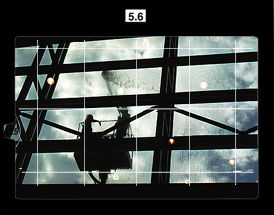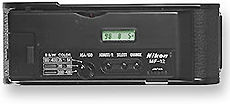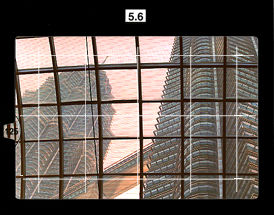Other than the speed boost, the FM2 also offers good utility features such as interchangeable focusing screens. Although hardly can it claimed to be a new feature as it has been used on earlier Nikon FE of 1978.
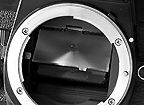 |
But it generally considered to be a very practical feature with such a wide selection of Nikkor lenses with variable lens speed available, some lenses may not be too comfortable to used with the standard general purpose standard K-type focusing screen. |
Certain specialized application may call for plain or grid screen such as close-up or photomicrography, super-telephotography and architectural photography in combination with slower lenses which may caused the split image to darken at one half.
Simply put, with the inter-changeability of screen, a photographer can realize greater imaginative possibilities with the Nikon FM2 than with many other 35mm SLR in its class. Relative: Nikon Focusing Screens for Nikon F, Nikon F3, Nikon F4, Nikon F5 & Screens for various MF-Nikon Mid-compact Bodies. |
 |
However, when the original FM2 was introduced, obviously Nikon has put little effort in this regard as they were more contented transferring the few useful features from FE to the new body. |
While Nikon FM2 inherited the focusing screen from the FE, (another being the viewfinder's flash ready light), FE2 and FA were introduced a year later with a NEW focusing screen type which Nikon claimed would boost a full stop brighter !
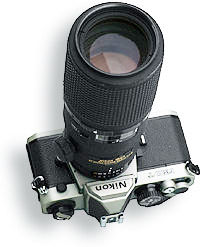 |
Yes. The FM2n was upgraded with the new screen when it was introduced a year later. The later FM2(n) models have a slightly different metering reference from earlier FM2 models which was introduced a year earlier due to the dimmer screen used ! So, we have some compatibility problem here arising: You can buy a new focusing screen (which comes in with a new designation, K2, B2 and E2 instead of the older Type K, B and E) and enjoy "a stop increase in brightness" with the oiginal FM2 but that applies only to viewing comfort but that is not the way the two SPD sensors that housed near the eyepiece would react. |
<<-- In most cases, the standard Type K screen would be sufficient to cover most photographic needs. It depends on one's personal type of photography, such as if your priority is focused on macro/close-up or working with some specialized optic that comes with smaller maximum aperture (such as the AF Micro-Nikkor 200mm f4 D ED IF shown at left); other optional screens may provide a better solution of maximum viewing comfort and ease of picture composing. If you are a owner of previous Nikon FE and possessed some older screen, you may interchange with your newer FM2n bodies with slight exposure compensation.
Unless you are using wide exposure latitude film such as negative; IF you are using a less forgiving slide film with the original FM2, you must take note if your unit is using a a NEW or OLD screen (Especially if you have bought your camera USED !) because you would need to perform some degree of exposure compensation.
|
Camera models |
Screen type |
Exposure adjustment |
Screen type |
Exposure adjustment |
|
FE, FM, and original FM2 |
K |
- |
K2 |
+ 1/3 stop |
|
B |
- |
B2 |
+ 1/3 stop |
|
|
E |
- |
E2 |
+ 1/3 stop |
|
|
FA, FE2, and FM2n/FM2/T |
K |
- 1/3 stop |
K2 |
- |
|
B |
- 1/3 stop |
B2 |
- |
|
|
E |
- 1/3 stop |
E2 |
- |
|
Models |
Metering |
EV |
Speed |
ASA |
MD |
Screens |
Sync |
DOF |
MLUp |
Shutter |
Back |
MExposure |
Wts |
Rating |
|
Nikon FM2n |
CW |
1-18 |
1-4000 |
12-6400 |
MD-11 & 12 |
3 |
250 |
Yes |
No |
Titanium, V |
MF-12& 16 |
provided. |
540g |
4/5 |
|
Pentax K-1000 |
CW |
3-18 |
1-1000 |
20-3200 |
Not available |
Fixed |
60 |
No |
No |
Fabric, H *** |
Fixed |
No |
525g |
2/3 |
|
OM-3 Ti**** |
CW, MSpots |
0-19 |
1-2000 |
6-3200 |
# * |
14 # |
** |
Yes |
No |
Fabric, H |
Databack 1-4 |
Rewind Btn |
540g |
5/4 |
|
OM-2000 |
CW; Spot |
2-19 |
1-2000 |
25-3200 |
Not available |
Fixed |
125 |
Yes |
No |
Aluminum, V |
Fixed |
provided |
430g |
3/4 |
|
Contax S2/B |
CW orSpot+ |
(0)4-20 |
1-4000 |
12-6400 |
Not available |
4 |
250 |
Yes |
No |
Aluminum, V |
Detachable++ |
provided |
565g |
4/4 |
|
Nikon FM10 |
CW |
2-19 |
1-2000 |
25-3200 |
Not available |
Fixed |
125 |
Yes |
No |
Aluminum, V |
Fixed |
provided |
420g |
2/3 |
|
Leica R6.2 |
CW, Partial |
-1-20^ |
1-2000 |
12-3200 |
MD; Winder |
5 # |
100* |
Yes |
Yes |
Aluminum, V |
Databack |
Rewind Btn |
625g |
5/3 |
Currency: US1-00 = RM3.80 (as at 23rd/April, 2000)
*
TTL
OTF (Through the lens Off the film flash Metering); ** FP sync provides sync speed from
1/60 to 1/2000 when used with F280 flash. Additional"X" setting provided;
# Built-in
dioptric
adjustment provided. #
*Motor Drive
1 & 2; Winder 1& 2
usable;
***
H=Horizontal; V= Vertical traveled shutter curtain; **** OM3Ti, the only model that provides
one
touch Hi/Low =Highlight and Shadow control; Rating: Technical spec/price
versus performance with consideration easy availability of parts and used accessories;
+ Two models
are available: S2 with Spot metering (EV4-19) OR S2b with center weighted metering
(EV 0-20).
++
No
Databack being announced yet for the model. ^Metering range for Leica 6.2 has
the best performance among all models featured here: EV-1 to EV20 (Center Weighted);
EV1-EV20 for partial spot metering.
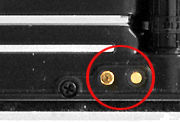 |
Another less noticeable improvement was - the camera finally had its body incorporated with a built-in Databack terminal to facilitate the used of cordless Databack. Although it might take a competition to realize how convenient Nikon has designed the Databack with good use of LCD (Liquid Crystal Display) technology *. |
However, both earlier Nikon FM and FE had not designed with a databack terminals on the camera which resulting the need to use a cord connection that plug into the PC terminal in front to work. Good news is, the earlier cord-connected MF-12 Databack is usable with any of the Nikon FM2, FM2(n) series Models, FE-2 and Nikon FA SLR (in fact, the cord is still available as new in Nikon product list).
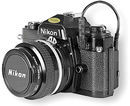 |
 |
 |
<<-- Photo courtesy of MClau
Both the newer version, MF-16 Databack and the original Data Back MF-12 can imprint on any frame your choice of Year-Month-Day, Day-Hour-Minute or any number from 0 to 99. It's ideal for documenting research or scientific data. Or for keeping a record of more personal moments. It can be used with MD-11 or MD-12 Motor Drive for imprinting data at speeds up to 3.2 fps. Both new and older Databack has a quartz timed clock with the MF-16 has the benefit of cordless attachment and with an alarm feature incorporated.
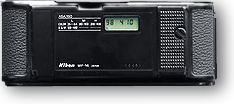 |
<<--MF-16 |
|
* LCD has an absolute
advantage in its longitivity of use. Where most rivaling manufacturers preferred
to use multiple dials and levers for their Databack input system which has limited
'life span" in terms of usable number of years to adjust. For an instance, Canon
Databack MA
can only adjust to year 1987. While an old Nikon
MF-12
can also act as a digital quartz clock, and has it programmed to the year 2100 !
(Nikon had apparently took into consideration of the Y2K bug during the early 80's,
in the design og their databacks!) There is also a useful flash ready light whenever
a Nikon dedicated flash unit is used. Also a "borrowed" idea from the FE,
where there is an extra electrical contact on the FM2's hot shoe activates a flash-ready
light in the camera viewfinder This LED light indicates that the flash is recycled
and ready to fire. It also will blink to warn the photographer when a shutter speed
has been set that's greater than the camera's top sync speed of 1/200 second.
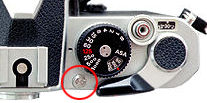 |
Nikon FM first pioneered the convenient push button multiple exposures operation which opens up a new level of convenience as compared with any previous Nikon bodies, including the professional Nikon F2s. |
However, FM's
separate button would still required a photographer to use two hands to operate and
the Nikon FE has relocate the button as lever just next to the film advance lever.
The wise move has enabled Nikon FE to perform Multiple Exposure with just a single
hand operation. The FM2 retained the proven film transport system utilizes in the
FE which permits extremely precise frame registration, and resulting in more accurate
and positive multiple exposures. And because the lever is positioned for easy fingertip
control, taking multiple exposures with the FM2 requires no special contortions.
It's even easier using motor drive, since you don't have to rewind the film. Big
deal ? Yes. Nikon's way of multiple exposure operation are by far the most convenient
and positive. You can add unlimited number of overlapping shots * and
when used in conjunction with a motor drive such as MD-11 or MD-12 - which remained
as an Nikon exclusive feature for quite a while, you can make use of fast motor driven
multiple exposures to create artistic impression.
* Depending
on number of exposures made, you need to perform exposure compensation i.e. underexposed
slightly. It is hard to give an reference, but to achieve best effects, try ! If you have
made some nice shots, mail to me and I will use them here to illustrate, Appropriate
credit will be given. Tips: Use a Tripod will help you in great deal !
The dual functions Self Timer. Most often, photographer treat this as a self timing device to release the shutter automatically. This feature is pretty useful in situation where the photographer wants to be included inside a picture like self-portraits or when taking a picture of yourself with other people.
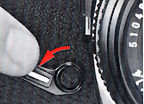 |
Switching on the self-timer lever gives you approximately ten seconds* before shutter release. The lever is easily visible from a distance and can be canceled at any point simply by returning it to its original position. |
Set the self-timer by turning the lever as far as it will go in the direction of the arrow shown in the photo. This can be done either before or after the film is advanced. After the self-timer has been set, press the shutter release button.
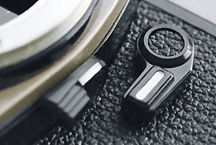 |
Reflex mirror will go up and the self-timer will start to operate; the shutter will released after a delay of approx. 10 sec. (* In a factory repair manual, it states "..8 to 14 sec...". In actual test, it ranges from 9 sec to 12 sec. on hand held timer). |
If you want to cancel self-timer operation after the lever has been set BEFORE it starts to countdown, just simply move it back to its original position with your finger. However, ALL Nikon mid compact bodies were designed such that returning the self-timer lever when it is already in operation will result in the shutter's being released the moment the lever is back in its original position. The self-timer can be used at any shutter speed except for B (bulb).
Now, that is the 'official' usage of a self timer. However, many seasoned Nikon photographers make use of the unique mechanism of camera's self timer design to minimize vibration caused by possible mirror bounce. Prior to the Nikon FM and FE in 1977/78, ALL Nikon bodies have a useful built-in mirror Lock up feature. Although initially it was intended to accommodate some special lenses that would require the main reflex mirror lock out of the way before they can be mounted; but most people would use it for specialized photography such as astrophotography or high magnification works without flash etc. which it may demand absolute still motion or vibration-less. The Nikon FM of 1977, strangely omitted that feature of mirror Lockup (Actually, to be fair - they are not alone, even company like Olympus, for an instance also decided to drop that feature from their second SLR model onwards; Canon ? does not fair any better ..) Such changes occurred with the rest of other midrange Nikon SLR models that followed.
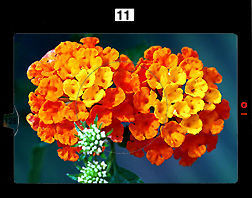 |
Today, only the professional level Nikon F series models still provide this unique feature. To compensate such omission, Nikon FM, FE series models and Nikon FA, FG were designed in such a way that the main reflex mirror will flip upward immediately once you activate self timer operation - which means it does in a way achieving similar purpose in minimizing possible vibration caused by mirror movement . |
<<-- Copyright ©-Free images collection, 2000 leofoo® Malaysian Internet Resources. Successful outdoor photography may has many others factors to be considered. For an instance, you have to overcome problems such as to tackle movement caused by wind, accessibility, lighting etc.. but the last thing you wish to see it happened is movement caused by your unsteady hand. Use a tripod or faster shutter speed would help a great deal, but at even higher magnification photography, considered combining other useful means with self timer operation with your FM2.
Advice ? For critically motionless photographic sessions, the trick is to use self timer to activate the shutter release with these mid-compact Nikons. Also remember that since the two SPD cells critical for metering is close to the eyepiece, do use something to cover up the viewfinder eyepiece if there is a strong light source behind the camera during a self timer operation which may sometimes affect metering accuracy.
 |
One of the key elements in successful photography is the intelligently use and creative control of of depth of field. So, other than using the DOF scales on the lens aperture ring to determine the degree of control over such effect, a more effective way is to make use of the Depth of Field Preview lever to visual check with the lens and f-stop selected. This is also used as a Stopped-Down metering activated lever to determine exposure. * Other than maximum aperture value on the lens is used, depressing the lever will 'dim' the viewfinder and may make focusing difficult, but you should also notice the gain in sharpness IN FRONT and BEHIND over the subject in focus. The smaller the aperture used, the dimmer it will be and DOF will also noticeably increased. |
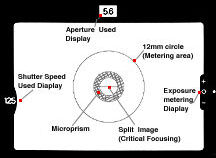 |
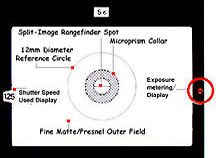 |
The viewfinder LEDs Display A direct comparison between Nikon FM and the newer Fm2n model shows changes are minute and earlier FMers will have no problems adapting to the new bodies. |
Despite LCD (liquid Crystal Display) was successfully implemented on the electronic Nikon F3 back in 1980, a higher contrast LED readout was still retained with the new FM model(s) as it has its clear superiority in low light reading. Further, as the FM2(n) is a mechanical camera which will still operate even without battery, priority is given to handling and visual comfort. The FM2, in this case, has an absolute advantage of enabling inter changeability of 6 different types of focusing screen ( 3 x older FE screens and 3 x newer/brighter Type 2) where on the FM, it is a fixed type.
The meter is 60% weighted towards the 12mm spot at the center of the screen (The fine focusing collar surrounding the rangefinder spot in a Type K /K2 screen, in the case of Type B/B2, the circular outline in the center of the picture frame, however, the grid lines Type E/E2 is not provided with any visual aid) improving overall exposure balance. |
It works like a partial metering pattern (the 12mm circle constitutes 13% of the picture frame), but with metering consideration of 40% over remaining viewing field.
<<-- Internal View of Petronas Twin Tower, Kuala Lumpur, current world's highest building. Copyright © 2000 CYLeow® The Star. Enlarged View JPEG: 67k)
The full information viewfinder of the FM2(n) has all the basic essential data helping you to determine an exposure. The set shutter speed and aperture used on the lens are shown. The pentaprism is silver-coated provides a viewfinder system that is more than comfortable to view and compose. It is adequately bright and relatively easy to read. All information is shown outside the imaging area for cleaner composition - a refined improvement over the earlier FM which has a protruding exposure indicator into the picture frame. The FM2's fixed eye-level pentaprism viewfinder's picture area covered is approximately 93% which corresponds to that of a mounted transparency. Magnification ratio is around 0.86X (50mm lens set at infinity) and projecting a relatively image size inside the finder.
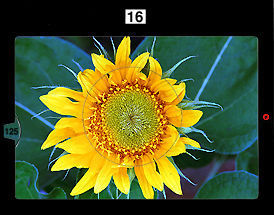 |
Although I thought this area can still be improved (either convert it into a high eyepoint finder to benefit some eyeglass wearers OR provide a higher magnification like those in the Olympus or Pentax bodies of the '80). |
Anyway, the
first was not practical as High eyepoint means smaller image inside the viewfinder
for focus and composing. However, Nikon decided the older viewing system in the FM
was good enough (means no one was complaining...) for everyone, why bother to change
them and incurred more development cost ? Err.....
|
Previous | Next | Other Issues Part
III (2/5
parts)
| Back | Index
Page of Nikon FM2 models
| Back | Index
Page of Nikon FM2(n) models
| Back | Main Index
Page of Nikon FM series Bodies
Full Specifications: Main Reference
Map
: HTML | PDF
Nikon
FM2n's Instruction
Manual
is ONLY available in HTML format
(6
parts)
| Message Board | for
your favourite Nikon
FM Series SLR models
| Message
Board | for your Nikon
Optics in a shared environment
| Message Board | Specifically for Dispose or Looking for Nikon/Nikkor
Photographic Equipment
Standard
production Nikon FM Series models:-
Nikon FM | Nikon FM2 | Nikon FM2n | Nikon FM10 | Nikon FM3a |
Known
variants:-
Nikon
FM Gold
| Nikon
FM2/T
| Nikon
FM2N Tropical Set
| Nikon
FM2/T Limited Edition
| Nikon
FM2N LAPITA
|
Nion
FM2n Millennium 2000
Shared Resources: MD-11 | MD-12 | Focusing Screens | Titanium Shutter | Flash Units -SB-16 | SB-15 | SB-10 or other Options | Databack | Nikkor lens mount (related info)
Others:- Nikon AF-TTL Speedlights | SB-20 (1986) | SB-22 (1987) | SB-23 | SB-24 (1988) | SB-25 (1991/2) | SB-26 (1994) | SB-27(1997) | SB-28 (1997) | Nikon SB-29(s) (2000) | Nikon SB-30 (2003) | Nikon SB-600 (2004) | Nikon SB-800 (2003) Nikon AF-TTL Speedlight DX-Series: Nikon SB-28DX (1999) | SB-50DX (2001) | SB-80DX (2002)
Nikon
BC-flash Series |
Original
Nikon Speedlight
SB-2
| SB-3 | SB-4
| SB-5
| SB-6 | SB-7E
| SB-8E
| SB-9 | SB-E
| SB-10
SB-11
| SB-12 | SB-14 | SB-140 UV-IR| SB-15 | SB16A | SB-17 | SB-18, SB-19 | SB-21A (SB-29) Macro flash | Flash Accesories | SF-1
Pilot Lamp
Instruction
Manual: Nikon FM (HTML | PDF) | Nikon FM-10 (HTML) | Nikon FM2n's
User's Manual
available only in HTML format (6
parts) | Nikon
FM3A
(HTML)
Specifications: Nikon FM, FM-10, FM2, FM2n and FM3A / Main
Reference Map: (HTML) Nikon FM, FM2, FM-10, FM2n (Applicable
to FM2T, FM2 "Year of the Dog"; Millennium 2000") and Nikon FM3A
| Nikon F | Nikon F2 | Nikon F3 | Nikon F4 | Nikon F5 | Nikon F6 | Nikkormat / Nikomat | Nikon FM | Nikon FE/ FA | Nikon EM/FG/FG20 | Nikon Digital SLRs | Nikon - Other models |
Nikon Auto Focus Nikkor lenses:- Main
Index Page
Nikon Manual Focus Nikkor lenses:- Fisheye-Nikkor Lenses - Circular | Full Frame |
Ultrawides Lenses - 13mm15mm18mm20mm | Wideangle Lenses - 24mm28mm35mm | Standard Lenses - 45mm 50mm 58mm | Telephoto
Lenses - 85mm105mm135mm180mm & 200mm | Super-Telephoto Lenses - 300mm 400mm 500mm 600mm 800mm 1200mm |
 Index Page |
Special
Application lenses: Micro-Nikkor Lenses - 50mm~55mm -60mm 85mm -105mm 200mm Micro-Zoom 70-180mm Perspective Control (PC) - 28mm 35mm PC-Micro 85mm Dedicated Lenses for Nikon F3AF: AF 80mm f/2.8 | AF 200mm f/3.5 EDIF Depth of Field Control (DC): 105mm 135mm Medical Nikkor: 120mm 200mm Reflex-Nikkor Lenses - 500mm 1000mm 2000mm Others: Noct Nikkor | OP-Nikkor | UV Nikkor 55mm 105mm | Focusing Units | Bellows-Nikkor 105mm 135mm Nikon Series E Lenses: 28mm35mm50mm100mm135mm | E-Series Zoom lenses: 36~72mm75~150mm70~210mm |
MF Zoom-Nikkor Lenses: 25~50mm | 28~45mm | 28~50mm | 28~85mm | 35~70mm | 36~72mm E | 35~85mm | 35~105mm | 35~135mm | 35~200mm | 43~86mm | 50~135mm | 50~300mm | 70~210mm E | 75~150mm E | 80~200mm | 85~250mm | 100~300mm | 180~600mm | 200~400mm | 200~600mm | 360~1200mm | 1200~1700mm
Tele-Converters: TC-1 | TC-2 | TC-200 | TC-201 | TC-300 | TC-301 | TC-14 | TC-14A | TC-14B | TC-14C | TC-14E | TC-16 | TC-16A | TC-20E
Recommended links to understand more technical details
related to the Nikkor F-mount and production Serial Number:
http://rick_oleson.tripod.com/index-153.html by: my
friend, Rick Oleson
http://www.zi.ku.dk/personal/lhhansen/photo/fmount.htm by: Hansen,
Lars Holst
http://www.mir.com.my/rb/photography/hardwares/nikonfmount/lens2.htm
http://www.photosynthesis.co.nz/nikon/serialno.html
W A R N I N G: The New G-SERIES Nikkor lenses have no aperture ring on the lens, they CANNOT ADJUST APERTURES with any of these manual focus Nikon FE series SLR camera models; please ignore some portion of the content contained herein this site where it relates.
|
Back | Main Index Page of Nikkor Resources
|
Back | Main Index Page of Pictorial
History of Nikon SLRs
| Message Board | for your Nikkor optics ("shared" because I do wish some of you to expose to other's perspective as well. Isn't it a sad sate to see photography has to be segmented into different camps from the use of various labels)
about this photographic web site
Home - Photography in Malaysia |
Credit: To all the good people who has contributed their own experience, resources or those who are kind enough granting us permission to use their images appeared in this site. Mr. MCLau®, who has helped to rewrite some of the content appeared this site. Chuck Hester® who has been helping me all along with the development of all these Nikon websites;LarsHolst Hansen, 'Hawkeye' who shares the same passion I have; Ms Rissa, Sales manager from Nikon Corporation Malaysia for granting permission to use some of the official content; TedWengelaar,Holland who has helped to provide many useful input relating to older Nikkor lenses; Some of the references on production serial numbers used in this site were extracted from Roland Vink's website; HiuraShinsaku from Nikomat Club Japan. t is also a site to remember a long lost friend on the Net. Note:certain content and images appeared in this site were either scanned from official marketing leaflets, brochures, sales manuals or publications published by Nikon over the years and/or contribution from surfers who claimed originality of their work for educational purposes. The creator of the site will not be responsible for may discrepancies arise from such dispute except rectifying them after verification."Nikon", "Nikkormat", "Nippon Kokagu KK" & "Nikkor" are registered tradename of Nikon Corporation Inc., Japan. Site made with an Apple IMac.
